If you’re wondering whether dropshipping is worth your time, this post will help you answer the question by reviewing every core aspect of the model.
These include its market, benefits & drawbacks, legal matters, tools, learning curve, communities, startup costs, and earning potential.
Let’s jump right in!
Dropshipping Model Explained
Dropshipping is an eCommerce fulfillment model in which a person sells products without owning them. When someone purchases an item from their store, they purchase it from a manufacturer, wholesaler, or another marketplace and have them shipped to the customer’s door by these third parties.
Essentially, the direct seller doesn’t need to hold any product inventory, handle packaging, or manage shipment, which significantly reduces upfront costs.
Is Dropshipping A Legit Business Model?
Dropshipping is 100% not a scam and totally a legit business model. It has been around since the 1960s and used by globally recognized brands like Gymshark, Zappos, Wayfair, Fab, and Gilt. Until the launch of AliExpress that opened up cross-border trade, dropshipping started gaining popularity.
Dropshipping is not a bad thing either. Think of yourself as a marketer promoting interesting products to people. If you provide high-quality goods at a better price with a more reliable service than other marketplaces like Amazon or eBay (e.g., free returns, full refunds, etc.), it benefits your customers more than harming them.
In fact, the dropshipping model shares a similar concept with how retailers work. Both are middlemen buying products from manufacturers or suppliers at low costs and sell them at higher pricing points to make profits.
Dropshipping Market Review
First, let’s do a quick dropshipping market review to see how big it is and the potential it can become in the future.
On the report of the global dropshipping market size, it’s anticipated to increase from $102.2B in 2018 to $557.9B in 2025, registering a whopping CAGR of 28.8%.
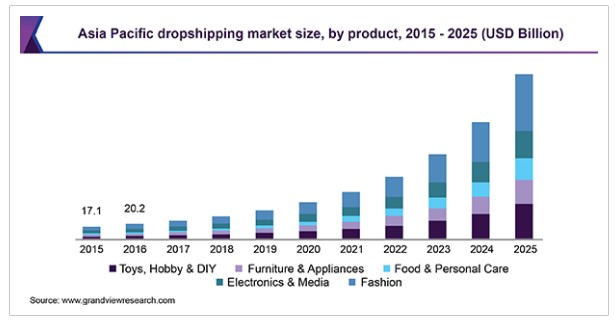
This growth is in tandem with the rise of eCommerce. As also reported by Grand View Research, The global eCommerce market is estimated to grow from $9.09 trillion in 2019 to $27.15 trillion in 2027 at a CAGR of 14.7%.

Researchers point out that the popularity of smartphones, the escalating trend in online shopping, and the rapid growth of cross-border trade are the main factors that drive the markets.
In addition, The COVID-19 pandemic has further accelerated the digital adoption process, making consumers more comfortable buying products off the internet.
According to Shift4Shop, 23% of online sales are processed via dropshipping. And, 33% of online stores use dropshipping as their main fulfillment method.
The model is also a big part of many eCommerce giants. Specifically, dropshipping accounts for 34% of items sold on Amazon. For eBay, the total dropshipping transactions on the platform have grown by 146% over the past few years.
In recent years, entrepreneurs are increasingly interested in dropshipping, proving by data collected by Google Trends.
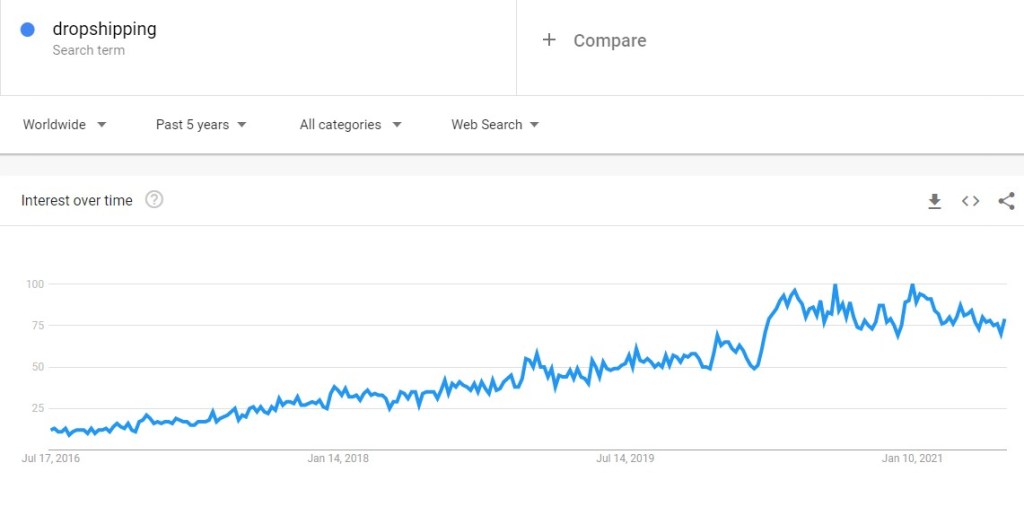
Dropshipping Pros & Cons Review
Next, we review the benefits and drawbacks of dropshipping. This will help you have a more realistic expectation when getting into the business.
First are the pros:
- Easy to get started: With the help of many powerful tools and platforms, along with plentiful guiding resources, anyone can get a dropshipping store up and running within a couple of hours or days max.
- Work anywhere: Since dropshipping operates entirely online, you can work on it anywhere and anytime you like.
- Minimum upfront investment: Dropshipping is a low-risk model because you don’t have to warehouse products or build a brick-and-mortar store. Promotions and order fulfillment are the two main expenses, which you can always reinvest your profits into them.
- Able to see results quickly: Advertising your products via platforms like Facebook Ads or Pinterest Ads enables you to immediately see how profitable they are and decide what to do next.
- Global market: It’s possible to sell your products to anywhere in the world, as long as your suppliers support it. It means no matter which dropshipping niche you’re in, there’ll always be an audience for it.
- Scaling potential: You have the chance to become something really big. Like we have mentioned, global brands like Gymshark or Wayfair used to be dropshipping stores. Until this day, a large part of their operation still heavily relies on dropshipping.
- Passive income: After you have set up an automatic system to promote products, collect your customers’ payments and fulfill their orders, you can literally make money dropshipping while sleeping.
- Valuable knowledge: Even if you fail, dropshipping is not a waste of time and money. The amount of knowledge you will learn, including supply chain management, market research, marketing, and copywriting, is immeasurable and can be applied to any other type of business.
Below are the cons of dropshipping:
- Low profit margins: Advertising costs and payment processing fees will eat up your profits. If you raise your product prices to make up for that, your conversion rates will decrease. Hence, it’s tough to generate a sizable profit margin.
- Rely on your suppliers: You have little to no control over product quality, fulfillment, packaging, and delivery. It means your suppliers can make or break your dropshipping business.
- Highly competitive: Besides fellow dropshippers, prepare to combat against small established brands and trusworthy eCommerce sites like Amazon, eBay, or Walmart.
- Branding difficulty: It’s tough to become a brand with dropshipping since your products can be sold by anyone.
- Payment processing issues: Many payment services like Paypal or Stripe consider dropshipping as a high-risk model since you don’t have any control over the backend. And, they can ban your payment accounts left and right.
- Problems with customer service: You might frequently get complaints from your customers because of slow shipping or low product quality.
- Troubles with returns, refunds, and chargebacks: For the same reason, your customers might want to get their money back and even open a dispute to do so. The return process is also annoying since you don’t directly distribute products.
Dropshipping Learning Curve Review
Dropshipping is not hard, but not a get-rich-quick scheme either. Although you don’t need to have any design expertise, coding knowledge, or any special skills to get started, you have to put in the work to learn website creation, store optimization, product research, and marketing to have a chance to compete in the market.
It’s estimated that the dropshipping success rate is below 10%, and it takes on average 3 months to make profits. To become wildly successful in dropshipping (e.g., making six figures/year), you need to spend at least 2-3 years with a minimum of 4 hours/day working on your store.
Dropshipping Earnings Review
Dropshipping is still very profitable. According to ECommerceFuel, dropshipping revenue and income both grow by more than 44% compared to the previous year – the highest number across all eCommerce business models.
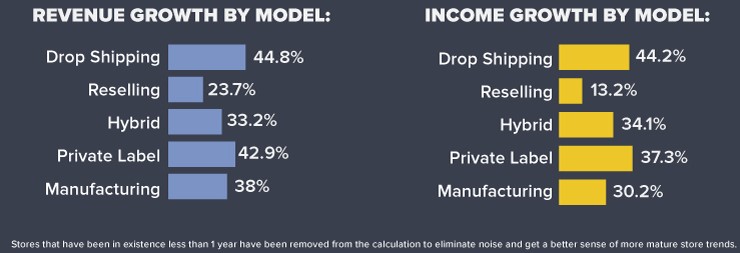
The average dropshipping conversion rate is 2.33%, an increase from 1.74% of the prior year.
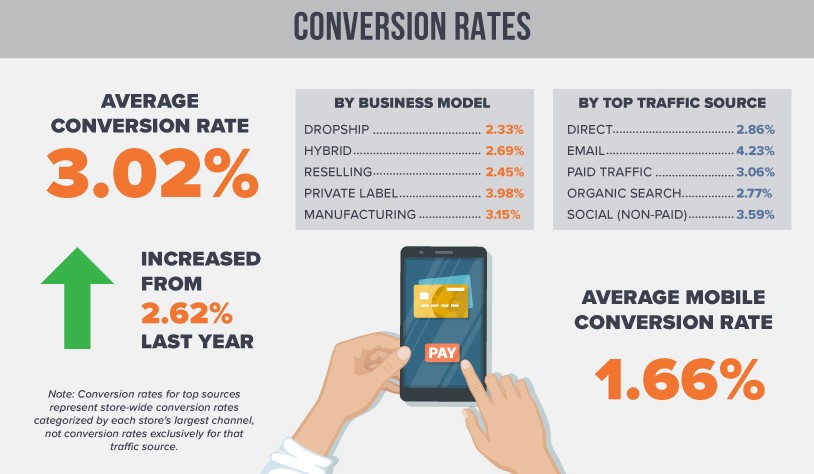
As also reported by ECommerceFuel, the average dropshipping gross profit margin is 32%, while the median net margin is 15%. Speaking of the average dropshipping order value, it’s $150, leading the eCommerce industry.
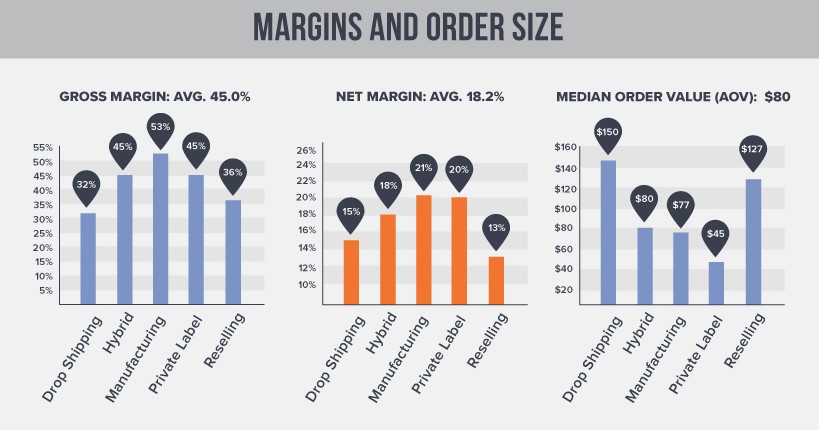
Beginner dropshippers could acquire 1,000 visitors/month to their store. Based on the average dropshipping conversion rate, net margin, and order value, their monthly net profit would be 1,000 * 2.33% * $150 * 15% = $524,25. It translates to $6,291/year.
Concerning eBay dropshippers alone, a quarter of them makes over $1,000 profit/month, while the top 10% earn $7,731/month in profit on average.
As you can see, if you have the right mindset and strategies, it’s entirely possible to get rich and live off dropshipping.
Dropshipping Startup Costs Review
Following, let’s review approximately how much money you need to start dropshipping.
First are fixed costs.
An eCommerce site builder, like Shopify, costs around $30/month. To make your dropshipping store look more professional, you will need a domain name and a custom business email, each costing about 10$/year. Additionally, you might use third-party applications, which are around $50/month for all. Adding them up, the total fixed costs for the first 3 months are $30 * 3 + $10 + $10 + $50 * 3 = $260.
Next are variable costs.
Given that it takes you $10 to get a buying customer (e.g., your ad budget each day) and $10 (including the processing fee) to fulfill the order, you will need about $600/month to reliably fulfill 30 units/month. That results in $1,800 for the first 3 months.
Altogether, the total recommended dropshipping startup costs are around $2,500. This includes fixed expenses for purchasing a store builder, a domain name, a custom email address, third-party apps, and variable costs for promoting products and fulfilling orders.
Dropshipping Legal Matters Review
As a beginner dropshipper, you don’t need to register a legal business to start dropshipping.
A business license is only necessary to make sure that your personal assets are not at risk if your business gets sued. For example, In the event of a lawsuit between you and your customers, they can only go after the assets of the legal entity (in this case, your dropshipping business), and that’s all they can get. They cannot get to your personal assets (e.g, your houses, cars, bank accounts, etc).
Taxes are a bit more complicated. When dropshipping, there’re 2 types of taxes you need to pay: income tax and sales tax.
You pay income tax to your country’s government only when you make a considerable amount of profit from your dropshipping store. For example, in the US, the minimum for single filing tax if under the age of 65 is $12,400. If your income is below that threshold, you generally do not need to file a federal tax return.
Sales tax is imposed by a government on the sale of goods and services. If you live outside the US, there’s generally a threshold of $100,000 or 200 sales transactions/year before having to pay sales tax.
If you live inside the US, consider watching this video for an easy-to-understand explanation.
Note that the information we provide here is not guaranteed to be 100% correct in your living country. We advise you to double-check against your government laws or consult a professional tax advisor or accountant for more details.
Dropshipping Communities & Support Review
Dropshipping has a large and active community. On Reddit, there’s a dropshipping forum with 129K members and plenty of other small subreddits talking about the model. Besides, you can find hundreds of dropshipping groups with thousands of members on Facebook.

Because of the rapid growth of dropshipping, major eCommerce companies have upgraded their infrastructure to support dropshipping services.
For instance, Shopify acquired the dropshipping service Oberlo for $15M in 2017. This allowed the company to hold a competitive position against its direct competitors.
Alibaba – the largest global wholesale B2B website – has also just announced its dropshipping platform called Alibaba Dropshipping Center. Now, anyone can quickly search for Alibaba dropshipping products with no minimum order requirement (no MOQ) and import them to their store to sell.
Regarding Amazon and eBay, as stated in their policies, they do allow and support dropshipping. However, you must assure that you’re the seller of record, meaning that your brand name (and no one else) is on all packing slips, invoices, and shipment packages.
Dropshipping Tutorials & Courses Review
A great thing about dropshipping is that it’s entirely free to learn the ins and outs of it.
There’s a lot of tutorials on YouTube teaching you how to create a dropshipping store, find winning products, run ad campaigns, fulfill orders, etc. Blogs like us also offer comprehensive guidelines on starting a successful dropshipping business.
Apart from that, Shopify Learning and Oberlo Learning provide completely free dropshipping courses, lessons, and advice from the best minds in the business.
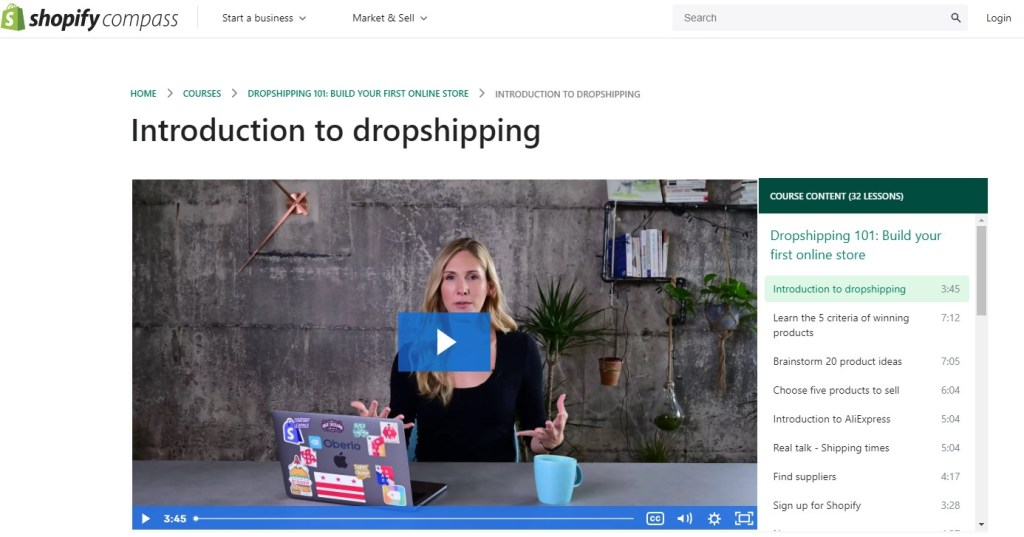
Dropshipping Tools Review
The next thing to review is the suite of tools to facilitate your dropshipping success journey.
Besides Shopify, WooCommerce, Magento, BigCommerce, Wix, Ecwid, and ShopBase are other powerful alternatives that heavily support dropshipping.
These platforms also have numerous built-in apps and plugins to help you automate your dropshipping store and extend its functionality to accommodate your business needs.
Furthermore, dropshipping research tools and dropshipping Chrome extensions like Sell The Trend, Ecomhunt, AliShark, Seller Pulse, or Dropispy make the process of finding winning product research and spying on competitors’ ads much faster.
In case you concern about the quality of Chinese goods on AliExpress or DHgate, you can easily find trustworthy US/UK/CA suppliers offering premium products on Spocket, Syncee, and Modalyst.
Who Should And Shouldn’t Start dropshipping?
Nothing is for everyone, including dropshipping. You should only start this business model if:
- You have little funds: As we have reviewed, the expense to build a full-fledged dropshipping store is $50-$300 max. And, the cost to test and fulfill the first few tens of orders is only another $1000-$2000.
- You have the willingness to learn new skills: managing an online store, researching markets, email marketing, dealing with customers, and operating a team are a few skills you might need to learn.
- You’re patient and perseverant: trial and error is the name of the game. it takes time and effort to know which product will sell, which strategy works best, how to boost conversion rates, and how to increase revenue with sales funnels.
- You want to understand how eCommerce works: Dropshipping gives you the opportunity to grasp your head around the whole eCommerce activity and how it operates.
Dropshipping is not for you if:
- You want to have complete control over your business: You only have command over the front parts, including promoting, communicating, and selling. If you obsess about shipping speed and quality consistency, dropshipping might not be for you.
- You don’t like the model: Despite being a legit business practice, dropshipping is sometimes badly perceived by people due to its price markup nature. If you don’t like it, consider other low-cost businesses like starting a blog, doing affiliate marketing, creating a YouTube channel, or making money with Instagram Reels.
Dropshipping Review – Conclusion
The purpose of this post is to show you reviews on every core aspect of the dropshipping business model.
Hopefully, with the information, you have a better grasp of how dropshipping works and decide for yourself whether it’s worth your time and effort.
Remember, the key to success is to be patient and consistent. Keep trying and failing, and you will eventually get to where you want to be.
The rightful owner of The Clever Business. I review & curate the leading suppliers so you don't waste time scouring the internet.




